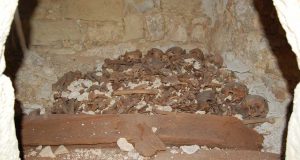Team of archaeologists discovered that a substantial minority of Byzantine-era monks buried in a communal crypt at Mount Nebo monastery, Jordan, display skeletal signs of hearing impairments.

Oil lamps found in the crypt date to the 700s. Bioarchaeologists now believe that it is possible that Early Christian monks’ vows of silence may have attracted not only the devout but also a fair number of hearing-impaired men with a sacred calling. About 16 percent of 57 male remains, found on a two-chambered crypt, displayed damage to middle ear bones caused by infections known as otitis media. This condition frequently occurs in childhood and can lead to lasting hearing problems even if the infection clears up quickly and monks showing signs of otitis media probably suffered mild to moderate hearing loss. Hearing loss would have had little effect on monks’ daily lives, since they communicated with hand signals, nods and other gestures. The researchers found damage to one middle ear bone, the stapes, in two other individuals likely caused severe hearing loss in one ear each and in another case, a fracture above the left eye could have damaged middle ear bones. Finally, one skull’s thickened bone may have resulted from Paget’s disease, a viral infection in adulthood that can impair hearing.
(after Science News & Margaret Judd)